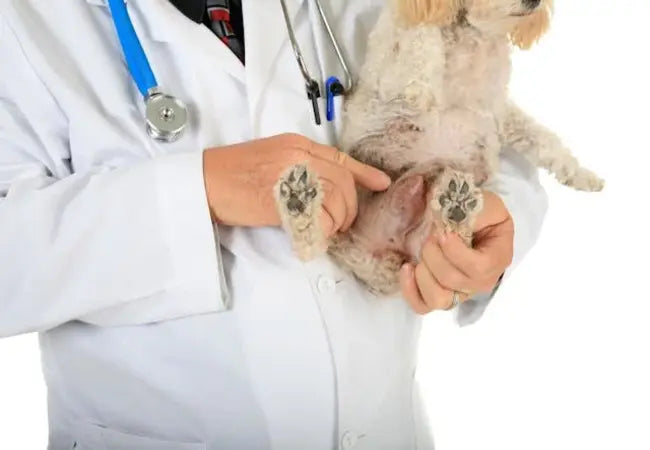Vaginal Abnormalities in Dogs: Veterinary Guide & Treatment Tips 2025 🩺🐾

In this article
Vaginal Abnormalities in Dogs: Veterinary Guide & Treatment Tips 2025 🩺🐾
By Dr. Duncan Houston BVSc
Hi, I'm Dr Duncan Houston BVSc, veterinarian and founder of Ask A Vet. Today’s 2025 article dives deep into vaginal abnormalities in dogs—from congenital strictures and septums to infections, hyperplasia, and prolapse. These conditions can impact urinary function, comfort, breeding, and infection risk. I’ll walk you through types, signs, diagnostics, treatment options, and home care, while showing how Ask A Vet, provides excellent support every step of the way. Let’s begin! 💙🐶
1. Understanding Vaginal Anatomy 🧬
The vulva is the external structure, while the vestibule includes the vaginal opening and urethral exit. Abnormalities can affect any part of this area—inside or out—causing symptoms like discharge, swelling, infections, pain, or reproductive issues.
2. Common Vaginal Abnormalities & Causes ⚠️
- Vaginal strictures or stenosis: narrow vaginal canal—congenital or acquired via inflammation or trauma.
- Transverse septum: tissue partition—may block or partially obstruct canal.
- Vaginal hyperplasia/prolapse: estrogen-driven swelling; appears during estrus and retracts afterward.
- Vestibular abnormalities: hooded/inset vulva or excess folds—retain urine, debris, moisture.
- Vaginal masses or tumors: benign or malignant growths causing discharge or obstruction.
- Vaginitis: inflammation due to infection (bacterial, viral, yeast), foreign bodies, or anatomical issues.
- Rectovaginal fistula: abnormal tract between rectum and vagina, allowing feces pass into vagina.
3. Who's Most Affected 🐾
- Puppies: "juvenile vaginitis" common—usually self-resolves.
- Intact females: estrus-related hyperplasia and vestibular issues occur with hormone surges.
- All ages, breeds: congenital defects present early; tumors and infections become apparent later in life.
4. Spotting Signs & Symptoms 🕵️♂️
- Abnormal vaginal discharge: mucus, pus, blood, or odor
- Redness, swelling, or prolapse of tissue from vulva
- Pain during mating, urination issues, or incontinence
- Frequent licking or scooting due to irritation
- Recurrent urinary or vaginal infections
- Fecal contamination of vaginal area in fistula cases
- Difficulty breeding, discomfort during mating
5. Diagnostics: Vet's Step-by-Step 🔬
- History & Physical Exam: includes visual, digital, and vaginoscopy.
- Vaginal cytology & cultures: detect infection, inflammation, hormonal cell changes.
- Urinalysis: identify urinary involvement.
- Imaging (ultrasound, X-ray): finds masses, strictures, fistulas.
- Biopsy or histopathology: for tumors or persistent lesions .
6. Treatment Options 🛠️
6.1 Juvenile & Mild Cases
- Cleanliness and monitoring—most cases resolve naturally.
- Topical or systemic antibiotics/antifungals if needed—guided by cultures.
6.2 Structural & Congenital Abnormalities
- Manual dilation: repeated under sedation for mild stenosis.
- Surgical correction: septum removal, stricturoplasty, vaginoplasty for abnormalities or fistulas.
6.3 Vaginal Hyperplasia/Prolapse
- While in estrogen surge (estrus), offer cold compresses and protect tissue.
- Spay (ovariohysterectomy) once hyperplasia resolves—prevents recurrence.
6.4 Infections & Masses
- Antibiotics or antifungals per culture .
- Mass removal and histopathology; further treatment if cancerous.
6.5 Vestibular/Vulvar Abnormalities
- Hygiene: regular cleaning with warm water .
- Surgery (e.g., episioplasty) is required for a recessed vulva or when dermatitis is severe.
7. Prognosis & Follow-Up 📅
- Puppy vaginitis: usually resolves post-first heat; excellent prognosis .
- Structural issues: corrected surgically with good outcomes.
- Infections: respond well to targeted therapy.
- Tumors: vary by type and malignancy—early removal improves prognosis.
- Follow-up exams, cultures, and imaging ensure resolution and early detection of recurrence.
8. Prevention & Home Care 🏡
- Maintain genital hygiene; trim fur and clean after potty breaks .
- Monitor for discharge, swelling, and licking—early signs of trouble.
- Spay at the recommended age to reduce risk of hormone-driven issues and infections.
- Prompt treatment of UTIs and irritations to avoid chronic problems.
9. How to Ask A Vet Support You 💡
- Ask A Vet: Remote guidance, vaginoscopy referrals, surgical follow-up.
10. When to Seek Veterinary Care 🚨
- Unusual discharge (mucus, pus, blood, odor) not due to heat.
- Persistent redness, prolapse, or swelling.
- Recurrent UTIs or urinary issues.
- Difficulty breeding or pain during mating.
- Visible masses, fistulas, or fecal contamination.
11. Final Thoughts 📝
Vaginal abnormalities in dogs cover diverse conditions—from harmless juvenile inflammation to serious structural defects. With careful observation, proper diagnostics, timely treatment, and consistent home care—many dogs recover fully. Spaying provides long-term protection, while Ask A Vet, offer comprehensive support for every step of your dog's care journey in 2025. 🐾💙
If you’ve noticed persistent vaginal symptoms or discomfort in your dog, don’t wait—schedule a telehealth appointment via AskAVet.com and download our app for personalized care and monitoring tools. 🌟






